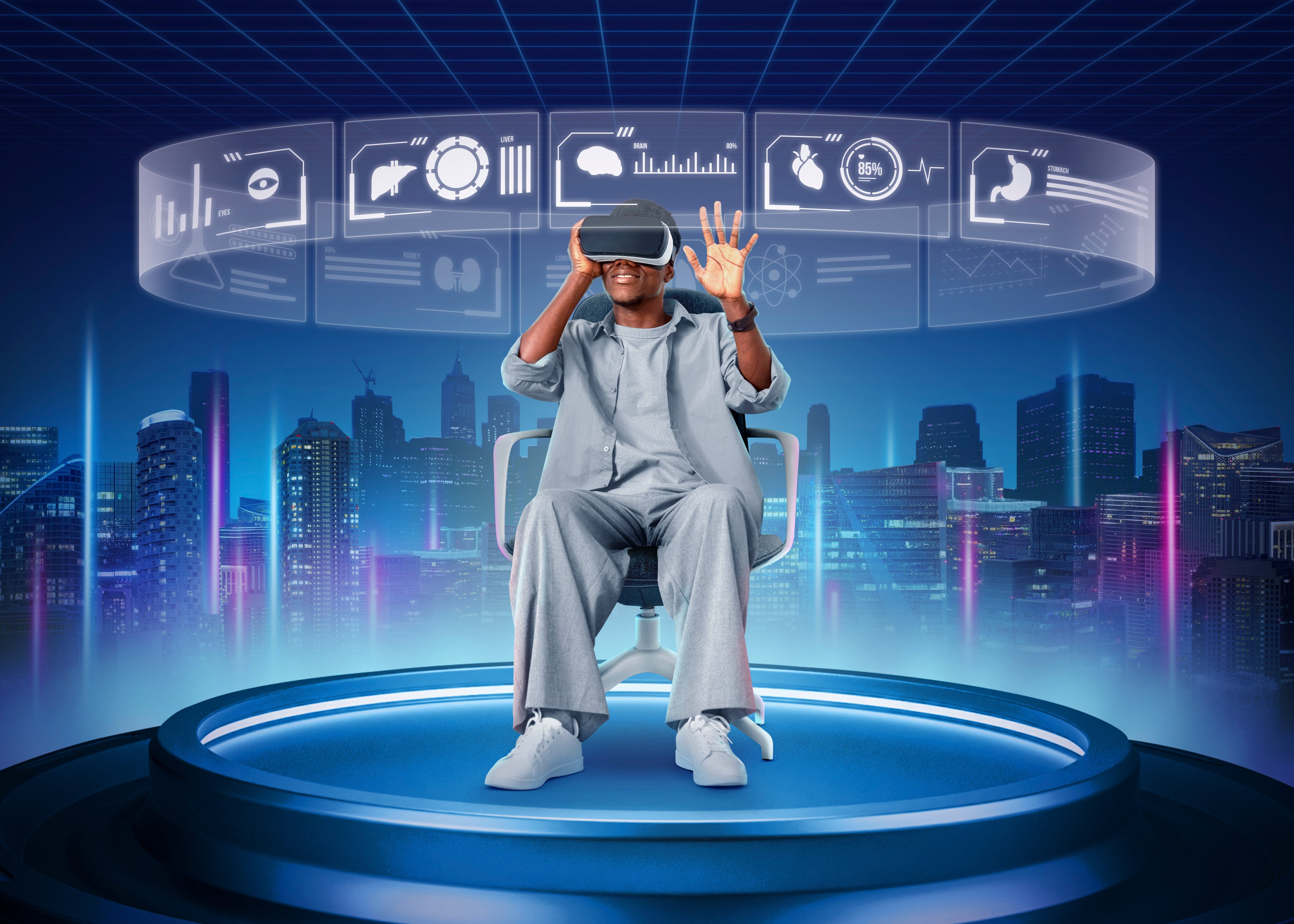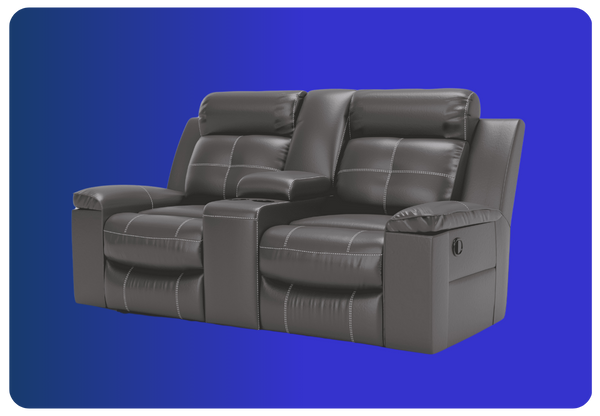Navigating the world of immersive technology can often be confusing. And while augmented reality (AR) and virtual reality (VR) may seem similar, they are far from interchangeable.
Each technology offers distinct experiences and uses that cater to different needs.
Let’s take a moment to demystify these innovative technologies, clarify the difference between virtual reality and augmented reality.
And explore how they transform our interaction with the digital world.
What Is Virtual Reality?
Virtual reality is a technology that creates a completely immersive environment, generated by computers, that simulates the sensation of being present in a different place or world.
Users experience this alternate reality through devices such as VR headsets or helmets.
These devices isolate them from their actual surroundings and project the virtual environment directly in front of their eyes.
Virtual Reality is an artificially created 3D environment which transports you to another world allowing you to see, hear and interact with objects in the simulated environment around you.
Interactions within a VR environment can vary widely.
In its simplest form, VR might offer a purely observational experience where users feel as though they have been transported to a new location.
But without the ability to move or interact within it.
More advanced VR setups allow for movement and interaction, which can be facilitated by additional equipment like motion-sensing gloves or gamepads.
This capability makes VR a versatile tool.
It’s often used for everything from entertainment and gaming to training simulations, providing a rich and engaging way to experience and interact with digital content.
Use Case Examples Of Virtual Reality
- Gaming:
The gaming industry is a standout example of using virtual reality to heighten the sensory experience.
VR games immerse players in richly detailed worlds where they can interact with the environment in highly realistic ways.
VR enables game creators to deliver a first-person experience that feels tangible, with intricate mechanics like manually reloading weapons, driving at high speeds, and puzzle-solving that engage players physically and mentally.
- Healthcare:
VR is increasingly used in healthcare for training surgeons and medical students with VR headsets.
It allows them to perform virtual surgeries, which can enhance their skills without the risks associated with real-life procedures.
Additionally, VR can be used for pre-operative planning, giving surgeons the ability to explore a patient’s anatomy in a three-dimensional space.
This can help them to understand complex structures better and plan surgeries more effectively.
- Real Estate:
In the real estate industry, VR is used to create detailed and immersive virtual tours of properties.
This technology allows potential buyers to explore homes remotely, providing a realistic sense of the space, layout, and design options without needing to physically visit the location.
This is immensely beneficial for international or out-of-state buyers who want to make preliminary decisions before travelling to see a property in person.
It’s also helpful in pre-sales to enable the buyer to visualize and get a feel of the end-product before construction is completed.
- Virtual Tourism:
Imagine strapping on a VR headset and suddenly finding yourself standing on the ancient stones of the Great Wall of China.
With virtual reality, users can embark on a guided tour along various sections of the Wall, experiencing its grandeur and historical significance without the need for travel.
This VR experience can include interactive elements such as historical facts, panoramic views, and even simulations of historical events related to the Wall.
It’s a fantastic way for education and tourism to merge, providing a deeply engaging way to learn about and virtually visit one of the world’s most famous landmarks.
Virtual Reality can be harnessed in different fields to enhance experiences, provide practical training solutions, or streamline processes that traditionally require physical presence.
What Is Augmented Reality?
Augmented reality is a transformative technology that overlays digital information—such as images, text, or interactive data—onto the real world.
Unlike virtual reality, which immerses users in entirely virtual environments, AR enhances real-world experiences by adding digital elements in real-time.
This blending of virtual and physical realities allows users to interact with both simultaneously.
A prime example of AR's impact is the phenomenon of Pokémon GO.
This mobile game used AR to superimpose Pokémon characters onto the real world through smartphone screens, leading millions of users worldwide to venture outdoors to 'catch' them.
This event significantly boosted AR's popularity, making it a familiar concept to a broad audience.
While VR creates isolated, immersive environments, AR relies directly on the real world to generate interactive experiences.
This dependency on real-world interaction makes AR versatile and applicable in various fields beyond gaming.
Some of these fields include industrial manufacturing, medical training, tourism, and education. Here it provides valuable enhancements to real-time decisions and interactions.
Augmented Reality applications are increasingly popular due to their versatility and the widespread availability of the necessary technology.
Most commonly, AR apps utilize smartphones and tablets because these devices are already integrated into daily life.
And they are equipped with the necessary cameras and sensors to overlay digital information onto the real world.
This makes AR easily accessible to many users without requiring additional hardware.
In addition to handheld devices, there is a growing trend in the development of wearable technology, such as AR glasses or goggles.
These wearables are designed to provide a more immersive and hands-free experience.
By wearing these devices, users can interact with digital content superimposed directly onto their real-world environment in a more natural and intuitive way.
This technology is particularly useful in applications that require free hands or enhanced situational awareness.
Some of these applications include manufacturing, surgery, or even for enhanced navigation in complex environments.
ARway.ai is a platform that allows you to create and share AR based interactive experiences quickly with ease.
Using innovative Spatial Computing Technology, AR navigation - ARway.ai enables you to launch immersive rich AR experiences with its ready-to-use no code templates.
No hardware, beacons or 3D scanning devices are needed.
You can easily design indoor navigation and wayfinding for your venue.
Or create location persistent augmented reality experiences like scavenger hunts, tours, holograms and so much more.
Components Of AR
Augmented Reality relies on several core components to merge digital content with the real world:
1.Camera And Sensors:These capture the environment and help the device understand its location and orientation. This is crucial for aligning digital overlays accurately.
2.Processing Power:AR requires robust processing to manage data from sensors, render visuals, and maintain seamless integration of digital content with live environments.
3.Projection System Or Tools:In devices like AR glasses, this system displays images directly within the user's field of view, blending digital content with the real world.
4.Display:AR can be experienced through various displays, including smartphones, tablets, and specialized AR wearables like glasses or HUDs.
5.Software:AR experiences are driven by software like ARway.ai’s web-based studio to generate engaging digital overlays.
6.Connectivity:Essential for accessing real-time data and cloud resources, connectivity ensures AR content is dynamic and updated.
7.User Interface (UI):Interfaces such as touch, voice, and gesture recognition allow users to interact naturally with augmented elements.
These integrated components of AR come together to create immersive experiences, enhancing our interaction with both digital and physical realms.
Use Case Examples Of Augmented Reality
- Navigation Technology
- City Exploration:
Imagine exploring a new city with augmented reality directions overlaid onto your real-world environment.
You can learn historical facts when you point your smartphone’s camera at a monument.
Or even check restaurant reviews by scanning the name of the restaurant with your phone’s camera or seeing it through AR glasses.
Augmented reality makes it all possible.
- Indoor Navigation:
In large complexes like airports, hospitals, campuses or shopping malls, AR can help visitors find specific stores, gates, or amenities.
This is done by displaying virtual arrows or paths on their device screens, guiding them through the space efficiently.
ARway.ai helps you launch indoor navigation simply by uploading a map of your venue and trigger multi-story navigation with AI optimized routes using visual markers.
Click here to find out how you can launch indoor navigation for your venue with minimal investment and the fastest turnaround time.
- Gaming
- Location-Based Games:
Following the success of games like Pokémon GO, AR has been used to create immersive games like scavenger hunts.
- Interactive Board Games:
AR can transform traditional board games by adding layers of digital content that interact with physical game pieces.
Players could see animated characters or effects on the board through their devices, enhancing the gameplay experience.
- Tours
-
AR can enrich visitor experiences in museums and galleries by providing added multimedia content.
This can include 3D reconstructions of artifacts, animations of historical events, and audio descriptions that activate when approaching specific exhibits.
- Training
- Medical Training:
AR is increasingly used in medical and healthcare training, where students can practice procedures on virtual patients or see anatomical details overlaid on mannequins.
This can enhance their understanding and skills without risk to real patients.
- Industrial Maintenance Training:
In industries, AR can guide technicians through maintenance processes by overlaying instructions, tool information, and safety warnings directly onto the equipment.
This can speed up training and reduce errors in complex tasks.
- E-commerce
-
Augmented Reality is revolutionizing e-commerce by enhancing how customers interact with products online.
Here are some examples of AR in e-commerce:
Virtual Try-Ons
- Fashion And Accessories:
Shoppers can virtually try on clothing and accessories, reducing guesswork and boosting satisfaction.
- Beauty Products:
Brands like Sephora use AR for customers to test makeup shades directly on their skin virtually, aiding in more confident purchase decisions.
Home Decor And Furniture
- Visualization:
Apps like IKEA Place allow users to virtually place furniture in their homes, checking fit and style before buying.
- Material Previews:
Shoppers can view different materials and colors in their actual space, ensuring decor matches seamlessly.
Enhanced Shopping Experience
- Interactive Catalogs:
Digital catalogs with AR features make online browsing engaging, turning viewing into a hands-on interactive experience.
- Personalized Shopping:
Integrating AR with AI for personalized recommendations tailors the shopping experience to individual preferences.
These AR innovations are making online shopping more dynamic, personalized, and reassuring, bridging the gap between digital exploration and physical product experience.
ARtize3D by Nextech3D.ai helps businesses transform the way they sell online with end-to-end 3D and AR models generated with AI.
ARtize3D is trusted by the world’s leading retailers to enhance their e-commerce experience with their patented 2D-3D technology and 3D configurators.
It offers seamless integration into your website with compatibility across devices.
It can also be used to generate AR ads and create unique shopping journeys powered by its customizer that easily integrates in Shopify as well.
You don’t need to hire expensive 3D designers and developers, with its turnkey solutions ARitize3D will do it all for you.
Click here to grow your e-commerce business with 3D and AR technology.
About Nextech3D.ai:
Nextech3D.ai is leading the charge in the 3D and AR revolution, leveraging advanced AI technology to create unparalleled 3D and AR experiences. As a pioneering force in the augmented reality landscape, Nextech3D.ai is dedicated to empowering businesses to adapt and thrive in the evolving 3D and AR ecosystem. With a portfolio of cutting-edge brands including ARitize3D, ARway.ai, and Map D - Nextech3D.ai stands as the premier solution provider, driving innovation and transforming industries through AI-enhanced 3D and AR technologies.









